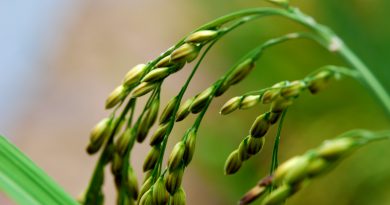Description and criteria for GIAHS selection
|
Characteristics of the proposed GIAHS should include global (or national) importance. Global (or national) importance is a composite criterion, under which the overall value is established of a traditional/historic agricultural system, represented by a particular site, as a heritage of human kind (or a country). It synthesises its overall Global (or National/local) “Public Good” value described under the five subsequent criteria. By summing up/combining the five criteria the complex relationships, and positive connectivity and linkages between the system’ elements are integrated as a holistic system. A summary information of the global importance of the individual characteristics of the system/site, with its intrinsic resilience and capacity to strike a social-environmental balance, by its historic and contemporary relevance for human development and by whether the site is a unique or outstanding example of the agricultural system it represents and a testimonial to an agricultural tradition in comparison with similar systems and sites. The outstanding (or unique) features of the system should be summarized in terms of their relevance to global concerns addressing sustainable development and ecosystems management and their cultural and agricultural heritage value. The Five Criteria for the selection of the Globally Important Agricultural Heritage System (GIAHS) represents the totality of the functionalities, goods and services provided by the system. These criteria are, as follows: 1. Food and livelihood securityThe proposed agriculture system should contribute to food and livelihood security of local communities (often indigenous), representing the majority of their livelihood provisions. This includes provisioning and exchange among local communities to create a relatively stable and resilient food and livelihood system. 2. Biodiversity and ecosystem functionAgricultural biodiversity and genetic resources (species, varieties & breeds), as well as other biodiversity such as wild relatives, pollinators and wildlife associated with the agricultural system and landscape. The system/ site should be endowed with globally (or nationally) significant biodiversity and genetic resources for food and agriculture (e.g. endemic, rare, endangered species of crops and animals). 3. Knowledge systems and adapted technologiesMaintain invaluable knowledge, ingenious technology and management systems of natural resources, including biota, land, water; and social organisations and institutions, including customary institutions for agro-ecological management, normative arrangements for resource access and benefit sharing, etc. 4. Cultures, value systems and social organisations (Agri-Culture)
Cosmo-vision, value systems and agri-cultural practices associated with environment and agricultural calendar; festivities and rituals as knowledge transfer. Local institutions play a critical role in balancing environmental and socio-economic objectives, in creating resilience and in the reproduction of all elements and processes critical to the functioning of the agricultural system. Some may ensure conservation of and promote equity in the use and access to natural resources; some transmit traditional knowledge systems and critical values that promote custodianship of biodiversity, land and water; some facilitate planning, cooperation and innovation/adaptation. Such institutions may take the form of ceremonial and religious beliefs and practices, including taboos, ceremonies and festivities; of customary law and conflict resolution, including on resource tenure; of kinship, marriage and inheritance systems; of forms of leadership, decision-making and cooperation; of oral and written traditions; of games and other forms of education and instruction; of division of roles and distribution of labour, including gender roles and specialized functions; etc (intangibles). 5. Remarkable landscapes, land and water resources management featuresLandscape features resulting from human management, that provide particularly ingenious or practical solutions to environmental or social constraints, such as land use mosaics, irrigation/water management systems, terraces, particular ecosystem adaptive architecture, which might provide for resource conservation/efficiency or provide habitats for valued biodiversity, recreational values collective or non commercial valuable uses (aesthetic, artistic, educational, spiritual, and/or scientific values of ecosystems). Other social and cultural characteristics pertinent to the management of the agricultural system (optional) Other goods and services generated by the system (incl. ecosystems services, climate adaptation and other environmental benefits of global importance or specific features such as archeological/historic value or contribution to political stability). For each element a range of sub-criteria will be developed. For instance, indicators can be developed for biodiversity on genetic, intra- and inter species, and endemic diversity, for interspecies dynamics, for ecosystem-diversity and integration, as well as for the taxonomic groups: plants, animal, microbial and ecosystem. Also, knowledge and cultural heritage endowments will be spelled out more concretely by creating specific categories, with indicators to match. The future development of detailed indicators is considered necessary on these characteristics. A proposed sixth category of the criterion has been added to allow for the description of specific additional benefits that may be of global importance. Indicators for this criterion include: Benefits Maximisation: Maximise economic, social, livelihood and environmental benefits. Social Cohesion and cultural expression: Promote social cohesion, solidarity and sense of belonging and identity, culinary culture, festivities, art and music, etc. Resource endowments and knowledge systems: Possess remarkable natural resource endowments (especially biodiversity) and intrinsic knowledge systems of global benefit. Social and Cultural Diversity: Represent diverse social and cultural, institutional and economic approaches to management. Public Goods: Provide global public goods and heritage which needed economic valuation. Traditional Knowledge: Maintain invaluable knowledge and technology about landscapes, genetic resources, human cultures, and social organisation and institutions. Relation to the land: everyday as well as associative values of the landscape and agro-ecosystem for peoples collective and individual survival and livelihood, their identity and spiritual, religious, philosophical life and the artistic expressions thereof. Historic relevance The contribution of the agricultural system/site to the domestication and development of agricultural biodiversity, the creation of valuable landscapes, the development of agricultural knowledge and technologies over generations , and to human, social and cultural development in general, constitutes its historic relevance. Additionally, the historic relevance is determined by whether the system/site has remained sustainable and has shown its resilience in the face of environmental and socio-economic changes over time. Contemporary relevance The systems’/sites’ contemporary relevance is established by its present and future capacity to provide food and livelihood security, to contribute to human well-being and quality of life, and to generate other local, national and global economic and environmental goods and services to its community and wider society. This criterion therefore relates to the relevance of an agricultural system/site to global or national policy and sustainable development challenges, most prominently achieving food security, human well-being and environmental goals, such as climate adaptation, carbon sequestration, water, land and biodiversity conservation. Under this criterion one should highlight particular lessons learnt or principles that can be derived from the system site, which might be applied elsewhere.
|
|
| Source: fao.vn |



